

The 100 Anni Di Corsa exhibition
By Cyclingnews Staff in Loria, Italy
Moser's "funny bike"
 |
Francesco Moser's 1984 Hour Record bike was the first "funny bike" designed in the wind tunnel specifically to conquer the World Hour Record.
Surrounded by an illustrious team including Doctors Conconi, Ferrari and Sassi, Moser trained for months for his record attempt in January 1984. His success was notable; Moser rode this bike to two consecutive records in four days; first, he smashed Eddy Merckx's existing 12-year-old record by 1,377 meters to 50.808 km/h, then came back on January 23, 1984 and bettered his own Hour Record by another 343 meters to set his final World Hour Record of 51.151 km/h.
Although the front end of Moser's Hour Record rig was somewhat conventional, the dramatic swoop of the rear triangle and lack of seatpost were two of the biggest innovations in bicycle design ever.
1974 Merckx
 |
Eddy Merckx had a long history of fiddling with his bike geometry and set-up. This is a Merckx that was built by one of his legendary mechanics, Ugo De Rosa around 1974. Note the Campagnolo Super Record chainset and derailleurs, Reynolds 531 tubing and De Rosa's trademark square fork crown. Signs of the times are the Super Champion rims, Unicanitor buffalo suede saddle and the huge drop of the Cinelli "Merckx" bars.
Gimondi '65 TDF Magni
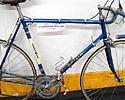 |
Ten years after Coppi rode in San Remo, a young Italian won the Tour de France at his first crack.
Felice Gimondi rode this blue Magni to victory; a "sottomarchio" of now defunct Italian bike brand Chiorda. Gimondi's bike had more upright angles than Coppi's bike and less fork rake, but maintained the same Campagnolo chainset, but with an updated "Record" derailleur.
Fausto Coppi's Bianchi
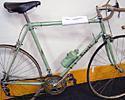 |
Fausto Coppi took the starting line in the 1955 edition of Milano-San Remo aboard this Bianchi, a race that was won by Coppi's runner-up in the 1953 World Championships, Romain Derijcke of Belgium.
Note the classic Celeste colour - Bianchi's trademark - integrated headset in the chromed headtube lugs and well-used Brooks B17 saddle.
Coppi's Bianchi drivetrain
 |
The drivetrain of Coppi's Bianchi sports Campagnolo's adjustable rear dropouts;, modern Gran Sport parallelogram derailleur; and a five speed rear cluster mated to the elegant first incarnation of Campagnolo's revolutionary Record, aluminium, cotterless, double crankset to give 10 speeds. This bike would set the template for modern bikes for the next 40 years.
Magni's Willier Triestina
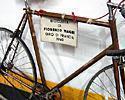 |
Fiorenzo Magni was the first Italian to win the Tour of Flanders and he did it three years in succession from 1949-51, a feat that no other rider has ever equalled.
Magni was sponsored by Wilier Triestina, a brand that was famous for it's copper-colored "ramata" finish. Here is Magni's bike from the '49 Tour de France, where he finished sixth on GC and was a key member of Fausto Coppi's winning team in the Campionissimo's first Tour win.
Note Magni's early Campagnolo derailleur, deep drop bars and solid fork crown.
Learco Guerra's Maino
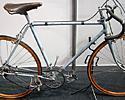 |
Nicknamed the Human Locomotive from his huge pulls, Learco Guerra had an illustrious pre-war career, racing from 1929-1942 with 83 wins.
Known as a superb time trialist, Guerra was world individual time trial champion in 1930 in Copenhagen.
Guerra won the 1934 Giro d'Italia aboard this Maino, equipped with Vittoria Margherita gears.
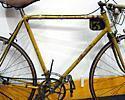 |
Gino Bartali's Legnano from his 1938 Tour De France victory.
After his crash into a mountain stream in the '37 Tour while wearing the Mailliot Jaune that lost him the race, "il pio" Bartali returned to the Tour de France in '38 at the head of an all-conquering Italian national team. Instead of the characteristic Legnano golden-green, Bartali's Legnano is yellow; the colour required by Tour De France founder Henri Desgrange's arcane rules.
Fausto Coppi's special Legnano track bike
 |
With World War II raging, it was on a cool November day in 1942 when Fausto Coppi ride this special Legnano track bike to the world hour record at Milano's Vigorelli Velodrome.
Coppi just beat Frenchman Maurice Archambaud's record of 45.817 km/h, set five years previously on the same Vigorelli track. Fausto rode a scant 31 meters further than Archambaud to establish a new World Hour Record of 45.848 km/h.
His record stood for 14 years, until the astonishing young rider Jacques Anquetil took the Hour back to France on June 29, 1956 with the first Hour over 46 km/h (46.159 km/h), destroying Coppi's record by 311 meters.
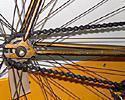 |
Detail of Fausto Coppi's 1942 Bianchi track bike
Ugo Bianchi had prepared a special superlight pursuit bike with thin, straight-gauge, non-ovalized chainstays and his direttore sportivo Eberardo Pavesi had obtained a special pair of lightweight wheels with wooden rims and 200-gram silk tubulars.
Note the filed-down track dropouts for lighter weight.
Vittoria Margherita gears on Alfredo Binda's Legnano
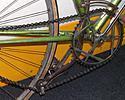 |
Here is a close-up of the Vittoria Margherita gear change that illustrious Italian champion Alfredo Binda used on his Legnano that brought the stylish Varesino to the first ever world professional title on August 31, 1932 in Rome, Binda still holds the absolute record for Giro d'Italia stage wins at 41 (he won five Giro's in total).
Libero Ferrario's Gloria
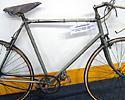 |
Milanese rider Libero Ferrario rode this Gloria to the World Amateur title in Zurich in 1923, where he crushed celebrated rivals Leducq and Wambst.
Note the double-sided rear hub and wing nuts, which was how riders would change gears until the advent of the first derailleur gears in the 1930s. Italian military champion at age 18, Ferrario had a brilliant three years from 1922-24, winning such races as Coppa Bernocchi and Milano-Genova, but succumbed to consumption at 29 in 1930.
Gloria was also the Milanese factory where Ernesto Colnago started his career in the 1940's.
1899 Bianchi
 |
This Bianchi was used by Tomaselli to win the 1899 edition of the once prestigious and now defunct GP Ville de Paris track meeting
Eddy Merckx's World Hour Record bike
 |
Poetry in motion... Eddy Merckx's World Hour Record bike from October 1972.
Merckx's World Hour Record was set at the high-altitude Olympic Velodrome in Mexico City and his steed may be the magnum opus of conventional diamond framed bicycles. Merckx pulverised Ole Ritter's record with the unbelievable time of 49.408km/h, 755 meters further than the Dane's record. However, Merckx paid the price that day; he had to be helped from his bike and carried off to recuperate.
Merckx's record stood for over a decade, until Francesco Moser used his high-tech aero bike and modern training methods to capture the Hour in 1984 at over 50km/h. Weighing under 8kg, Merckx's Colnago had special 3/10 superlight Colombus tubing and some of the earliest titanium parts.The bike's headset, stem, cartridge BB and titanium chain were reportedly manufactured by legendary Italian machinist/bike part inventor Pino Morroni of Detroit, Michigan.
Photos
Images by Tim Maloney/Cyclingnews
- Eddy Merckx's World Hour Record bike from October 1972
- Milanese rider Libero Ferrario rode this Gloria to the World Amateur title in Zurich in 1923
- This is a Merckx that was build by one of Eddy's legendary mechanics, Ugo De Rosa
- In 1942, Fausto Coppi rode this special Legnano track bike to the world hour record at Milano's Vigorelli Velodrome
- Felice Gimondi rode this blue Magni to victory in the '65 Tour De France
- Gino Bartali's Legnano from his 1938 Tour De France victory
- Fausto Coppi's Bianchi drivetrain
- Detail shot of Fausto Coppi's 1942 Bianchi track bike
- A close-up of the Vittoria Margherita gear change that Italian champion Alfredo Binda used on his Legnano
- Fiorenzo Magni's Wilier Triestina from the '49 Tour de France
- Close up of Guerra's 1934 Giro d'Italia & Vittoria Margherita gears
- Close-up of Gino Bartali's Legnano from his 1938 Tour De France win
- This Bianchi was used by Tomaselli to win the 1899 edition of the now defunct GP Ville de Paris
- Fausto Coppi took the starting line in the 1955 edition of Milano-San Remo aboard this Bianchi
- Guerra's 1934 Giro d'Italia Maino from the front
- Francesco Moser's eponymously named bike was the first "funny bike" designed in the wind tunnel to conquer the World Hour Record
- Learco Guerra won the 1934 Giro d'Italia aboard this Maino, equipped with Vittoria Margherita gears.
- Detail shot of Francesco Moser's World Hour Record "funny bike"